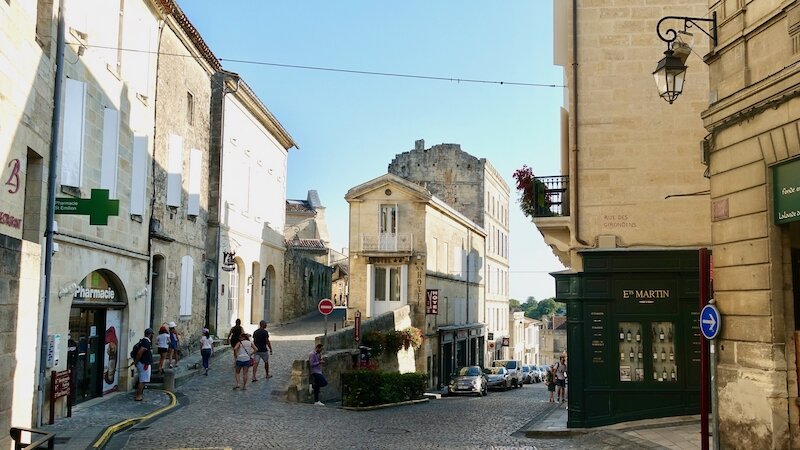Macarons In St. Emilion, France
The name of St. Emilion is synonymous with wine. The Romans first planted grapes in this region over two thousand years ago and by the 4th century the wines produced in the region were already being celebrated in poetry. Wine production has never stopped since then and today some of the most famous names in the world of wine are created in the great châteaus around the village of St. Emilion.
Vineyards provide the most striking images of St. Emilion, perfectly manicured rows of vines stretching out to the horizon. Tourists from around the world come to visit the region and even those who are not great aficionados of wine can appreciate the striking beauty of the landscape.
There is a lot of history in St Emilion because this was a hotly contested area during the Middle Ages. South-western France was part of the kingdom of Eleanor of Aquitaine who joined it to the crown of England when she married Henry II in 1152.
For the next several centuries this was English territory, though always contested by the French. Warring armies repeatedly rampaged through the region, leaving behind ruins of castles and defensive walls that today form a picturesque backdrop to the vineyards. Through all this turbulence the English developed a taste for French wines and the region thrived as an exporter of wines for the English market.
St Emilion is equally famous as a religious destination. Emilion was a seventh-century hermit who built a sanctuary in a cave in the rocky cliff that splits the village today, with houses both above and below it. Steep cobbled paths and staircases connect the two parts of the village, their stones worn smooth by centuries of use, creating a slippery hazard for unwary tourists!
The reclusive monk attracted disciples who after his death built a church that became a pilgrimage site. Today the church has grown into an enormous building that looms above the village.
The growth of St. Emilion as a religious centre attracted other monks and soon monasteries of the Benedictine, Augustin, Franciscan and Dominican orders were established here. An Ursuline convent opened here in 1620, dedicated to educating poor girls, but it became famous for a very different reason: the delicious macarons they produced!
The recipe for macarons had evolved over centuries in Europe. The technique of mixing ground almond paste and sugar to make sweets was a very ancient one, first developed by Persians and made popular by Arabs across the Mediterranean. In Italy the word maccherone, meaning a paste, was used to refer to both pasta (macaroni) and also a dessert made of almond paste with rose water and sugar.
By the seventeenth century French cooking was evolving into its modern form, leaving behind Arab inspired flavours such as rose water. The almond paste was combined with egg-whites to create light, airy puffs known as macaron. These were especially popular in religious houses where they could be eaten on fast days when meat was forbidden. When nunneries were forced to shut down after the French Revolution nuns opened shops selling macarons, making them available to everyone.
Europeans carried the recipe for macarons throughout the world with them. Portuguese traders brought them to southern India where today you can find macarons made with local cashew nuts substituted for almonds!
St. Emilion macarons are traditionally made with soaked, peeled, freshly ground almonds, giving them their typical marzipan like flavour. The secret recipe, brought to St. Emilion by Ursuline nuns in the 17th century, has been handed down generations and is still used by Nadia Fermigier in her famous shop Véritables Macarons de Saint Emilion.
I have simplified the recipe by using almond flour instead of fresh almond paste and added cardamom to my macarons as a nod to their Indian heritage. They are perfect with a cup of espresso to balance their sweetness and bring out their intense almond flavour. Enjoy them warm and soft or let them cool and crisp up lightly - delicious either way!
For another crisp, nutty and utterly delicious treat, try my Chocolate Hazelnut Cookies!
Cardamom Macarons
1 1/2 cups finely ground almonds (almond flour)
1 cup granulated sugar
1 tsp ground cardamom
3 egg whites
Pinch of salt
Preheat oven to 350F. Line two baking trays with parchment paper.
Combine ground almonds, sugar and ground cardamom in mixing bowl.
In another large bowl, using a hand mixer beat egg whites with a pinch of salt until soft peaks form.
Gently fold in the ground almond mixture with a spatula, until combined.
Using a rounded tablespoon or an ice cream scoop (you can also pipe them through with a pastry bag if desired), gently drop walnut sized balls of the cookie dough onto the prepared trays, spacing them 2 inches apart. Cookies will flatten as they bake.
Bake for about 14 minutes, until cookies puff up, tops are cracked and bottoms are lightly browned. Do not overcook, the centres should be slightly chewy. Cookies will dry out slightly and become crisper as they cool.
Cool cookies completely before storing in an airtight container.
Makes about 15 macarons











